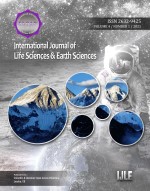Change in the agrochemical properties of soils and the productivity of the wheel under the influence of electromagnetic waves
Keywords:
agriculture, agrochemical, geographic information systems, power lines, soilAbstract
In recent years, in the world, the anthropogenic impact on the soil, entailing various changes in its properties, is becoming more severe. Especially it is necessary to note the lands located on the boundaries of the protection zones of linear objects. This article studies the agrochemistry of soils that are under zones and linear protection objects and the effect of electric waves on wheat productivity. Overhead power lines have a negative impact on the environment, in particular on its ecological, social, and economic systems due to the high intensity of the electromagnetic field around the lead wires. High-voltage power lines do not significantly affect the content of humus and nutrients.
Downloads
References
Abdullayev, I. N., & Marupov, A. A. (2020). The Analysis Of Lands In Security Zones Of High-Voltage Power Lines (Power Line) On The Example Of The Fergana Region.
Basso, F., Bove, E., Dumontet, S., Ferrara, A., Pisante, M., Quaranta, G., & Taberner, M. (2000). Evaluating environmental sensitivity at the basin scale through the use of geographic information systems and remotely sensed data: an example covering the Agri basin (Southern Italy). Catena, 40(1), 19-35. https://doi.org/10.1016/S0341-8162(99)00062-4
Bastian, C. T., McLeod, D. M., Germino, M. J., Reiners, W. A., & Blasko, B. J. (2002). Environmental amenities and agricultural land values: a hedonic model using geographic information systems data. Ecological economics, 40(3), 337-349. https://doi.org/10.1016/S0921-8009(01)00278-6
Brussaard, L., De Ruiter, P. C., & Brown, G. G. (2007). Soil biodiversity for agricultural sustainability. Agriculture, ecosystems & environment, 121(3), 233-244. https://doi.org/10.1016/j.agee.2006.12.013
Corwin, D. L., & Lesch, S. M. (2005). Apparent soil electrical conductivity measurements in agriculture. Computers and electronics in agriculture, 46(1-3), 11-43. https://doi.org/10.1016/j.compag.2004.10.005
Karhu, K., Mattila, T., Bergström, I., & Regina, K. (2011). Biochar addition to agricultural soil increased CH4 uptake and water holding capacity–Results from a short-term pilot field study. Agriculture, ecosystems & environment, 140(1-2), 309-313. https://doi.org/10.1016/j.agee.2010.12.005
Lagacherie, P., & McBratney, A. B. (2006). Spatial soil information systems and spatial soil inference systems: perspectives for digital soil mapping. Developments in soil science, 31, 3-22. https://doi.org/10.1016/S0166-2481(06)31001-X
Mamanazarovna, E. M., & Abbosxonovich, M. A. (2021). Analysis of Agricultural Soils Designation of Different Linear Protected Zones using GIS Technology. CENTRAL ASIAN JOURNAL OF THEORETICAL & APPLIED SCIENCES, 2(11), 188-192.
Marupov, A. (2020). Improvement of innovative mechanism for rational use of natural and land resources in Uzbekistan. Collection of scientific works ???? , 100-101.
Marupov, A., & Axmedov, B. (2020). General Characteristics Of Zones With Special Conditions For Using The Territory Of The City Of Fergana. Collection of scientific works ???O?, 7-10.
Marupov, A., Turamuratova, G., Rasulova, M., & Marupov, U. A. (2021). Soil Solarization and Sideration in Cotton Wilt Control in Uzbekistan. Annals of the Romanian Society for Cell Biology, 3259-3270.
McLaughlin, A., & Mineau, P. (1995). The impact of agricultural practices on biodiversity. Agriculture, Ecosystems & Environment, 55(3), 201-212. https://doi.org/10.1016/0167-8809(95)00609-V
Neverova, O. P. (2011). Shherbakov IV The total catalase activity of soils and CCS in the National Park «Smolenskoye Lake District». Agrarian Bulletin of the Urals, (2), 81.
Numanovich, A. I., & Abbosxonovich, M. A. (2020). About The Special Regime Of Use And Standards Of Land Plots And Their Buffer Zones Located In Borders Of Roadside Strips Of Highways Of The Ferghana Region Of The Republic Of Uzbekistan. The American Journal of Engineering and Technology, 2(09), 77-81.
Rehakova, M., ?uvanová, S., Dzivak, M., Rimár, J., & Gaval’Ova, Z. (2004). Agricultural and agrochemical uses of natural zeolite of the clinoptilolite type. Current Opinion in Solid State and Materials Science, 8(6), 397-404. https://doi.org/10.1016/j.cossms.2005.04.004
Sadguna, D. N., Sulistiawati, N. P. A., & Astiari, N. K. A. (2017). Contributions of household income of farmers as palm crafts outside agriculture sector. International Research Journal of Engineering, IT & Scientific Research, 3(5), 86-96. Retrieved from https://sloap.org/journals/index.php/irjeis/article/view/579
Saravanadurai, A., & Manimehalai, N. (2016). Primary agricultural credit societies in India. International Research Journal of Engineering, IT & Scientific Research, 2(7), 51-61. Retrieved from https://sloap.org/journals/index.php/irjeis/article/view/498
Soane, B. D., & Van Ouwerkerk, C. (1994). Soil compaction problems in world agriculture. In Developments in agricultural engineering (Vol. 11, pp. 1-21). Elsevier. https://doi.org/10.1016/B978-0-444-88286-8.50009-X
Thapa, R. B., & Murayama, Y. (2008). Land evaluation for peri-urban agriculture using analytical hierarchical process and geographic information system techniques: A case study of Hanoi. Land use policy, 25(2), 225-239. https://doi.org/10.1016/j.landusepol.2007.06.004
Turdaliev, A., Yuldashev, G., Askarov, K., & Abakumov, E. (2021). Chemical and biogeochemical features of desert soils of the central Fergana. Agriculture (Pol'nohospodárstvo), 67(1), 16-28.
Yuldashev, G., & Marupov, A. A. (2019). Main ways to improve the efficiency of agricultural land use in the Fergana valley sample. Scientific Bulletin of Namangan State University, 1(8), 68-74.
Published
How to Cite
Issue
Section
Copyright (c) 2021 International journal of life sciences & earth sciences

This work is licensed under a Creative Commons Attribution-NonCommercial-NoDerivatives 4.0 International License.
Articles published in the International Journal of Life sciences & Earth sciences (IJLE) are available under Creative Commons Attribution Non-Commercial No Derivatives Licence (CC BY-NC-ND 4.0). Authors retain copyright in their work and grant IJLE right of first publication under CC BY-NC-ND 4.0. Users have the right to read, download, copy, distribute, print, search, or link to the full texts of articles in this journal, and to use them for any other lawful purpose.
Articles published in IJLE can be copied, communicated and shared in their published form for non-commercial purposes provided full attribution is given to the author and the journal. Authors are able to enter into separate, additional contractual arrangements for the non-exclusive distribution of the journal's published version of the work (e.g., post it to an institutional repository or publish it in a book), with an acknowledgment of its initial publication in this journal.















